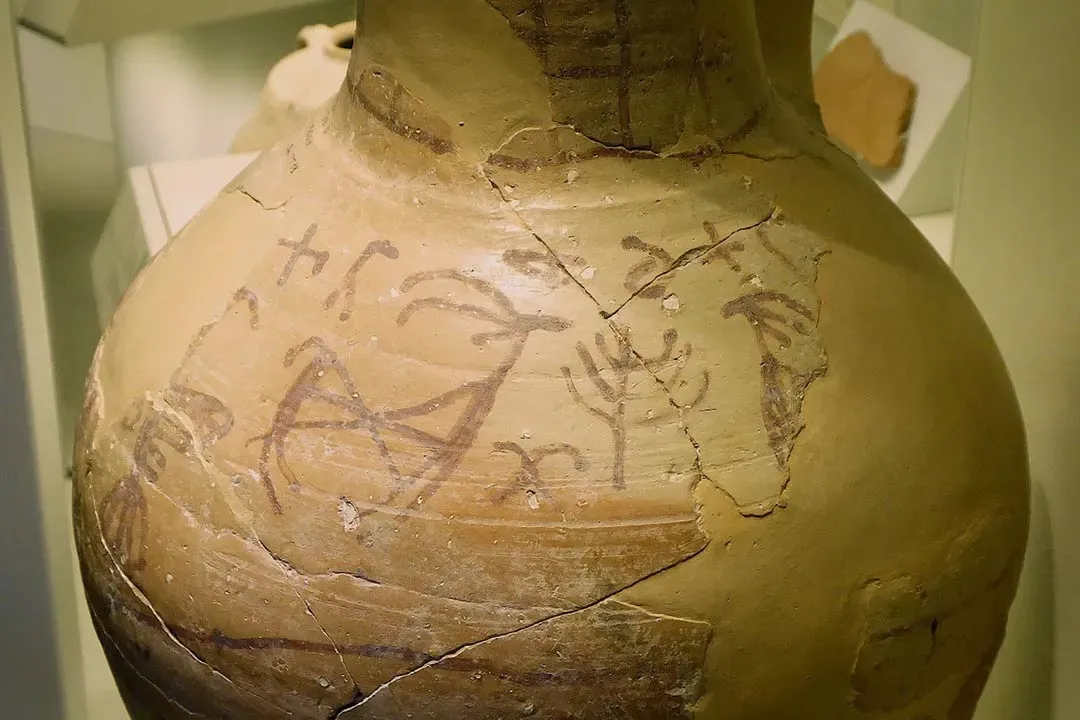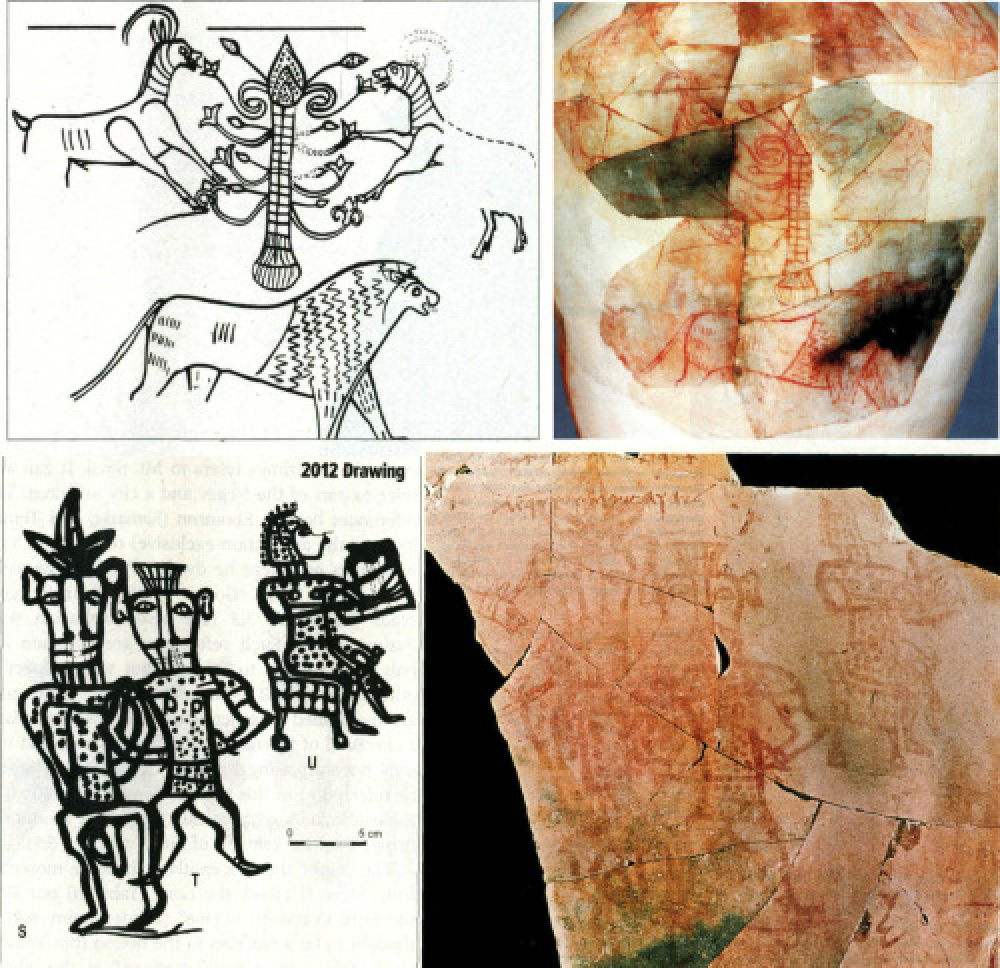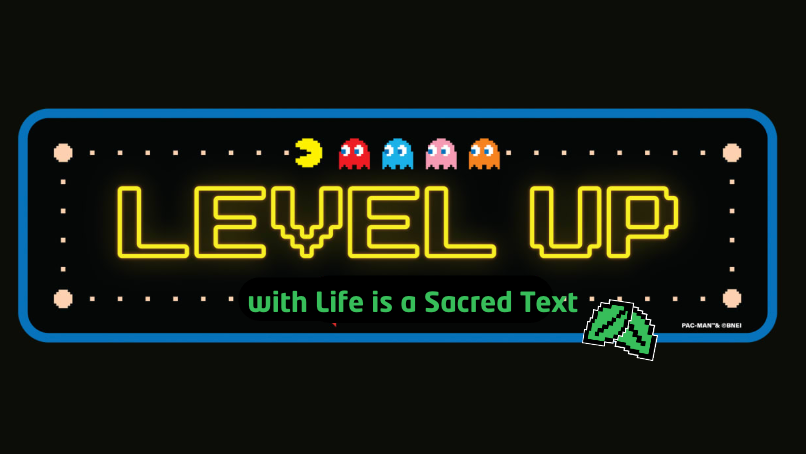Israelite Goddess Mystery Quest
smashing pillars / tracing echoes

This is Life as a Sacred Text 🌱, an everybody-celebrating, justice-centered voyage into ancient stories that can illuminate our own lives. It‘s run on a nonprofit, so it’s 100% NAZI FREE. More about the project here, and to subscribe, go here:
First of all:
May's Zoom Salon is coming up!
What We Say Tells Us Who We Are: Torah and Metaphor
Sunday June 8th, 2pm ET/1pm CT /11 am PT
We talk about sacred text as fire, as water, as the living tree. As the inverted mountain. As so many other things. Why? What does that tell us about who we are, and what we seek; how we see ourselves; about facing ultimate truth; and the difference between what we want and what we need.
Join a rollicking journey through delightful, thought-provoking midrash that offer the soul nourishment we badly need today.
(As always, cost should never be a barrier to Torah; info at bottom of email to get in touch if you want in but paying's not for you now.)
Now.
Today we're going to talk a lot about an Ancient Near Eastern goddess whose name, in various forms, appears all over the Bible, and who also pops up in archeology–
who was almost certainly a much bigger part of First Temple Israelite religion than we talk about–
and who also may have an entirely different name than the one to which we are accustomed.
Let's back up a bit.
First of all, the Hebrew Bible contains something like 40 or more references, explicit or more veiled, to Asherah– what it calls the deity– or asherot– used to represent her worship. Things like this, from Deuteronomy 16:
You shall not set up a sacred post (asherah)—any kind of pole/tree beside the altar of God your God that you may make (Deuteronomy 16:21)
or!
you shall tear down their altars, smash their pillars, cut down their sacred posts (asherot), and consign their images/idols to the fire. (Deuteronomy 7:5)
Deuteronomy 7:1 tells us that the "their" in this second verse is about
the Hittites, Girgashites, Amorites, Canaanites, Perizzites, Hivites, and Jebusites, seven nations much larger than you....
Implying that this is a non-Israelite practice.
Though, as we say, every sign has a story– this wouldn't be prohibited if there were zero Israelites doing these things.
And, indeed, we find all over the Bible that the Israelites were, at various points, worshipping Asherah. Judges 2:13 tells us that they did so not long after they settled into the Promised Land, just a generation or two after the Exodus.*
2 Kings (16-23, variously) tells us that King Ahab of the northern kingdom of Israel (10th-9th c. BCE) got into Asherah worship, and the book also blames the fall of Israel to the Assyrians in 722 BCE on the Israelites' various idolatries, including use of asherim and that they "made an Asherah." Meanwhile, in the southern kingdom of Judea, 2 Kings says that King Hezkiah (8th-7th c. BCE) cut down the asherot in Judea, that his son Manasseh reinstituted them, and, of course, we know that Manasseh's grandson Josiah smashed them when he ascended the throne.
*As we've discussed, there isn't exactly scholarly consensus that the Exodus was a historical event, rather than a sacred myth. (Sorry.) Scholars have a range of opinions about the Book of Judges, from those whose read on the archeology is that the book may be from the era it describes to those who argue that it's from much later, more an insertion of mythic history akin to things that might get written today about the founding of the U.S., l'havdil. If you wanted to go with when Judges is said to take place, it's roughly 3000 years ago, give or take.At minimum, we've got a lot of Israelites and Judeans– including some kings! – engaging in these practices and worship, despite Hezekiah and, later, Josiah's, reforms. King Josiah, if you will recall, is likely very responsible for shaping Deuteronomy's narrative. We'll come back to that in a second.
I've recently found some very compelling papers arguing that, in fact, her name wasn't originally Asherah, as she (and altars to her) are called in the Bible.
Rather, across the region, including originally to those of Israel/Judea, she was likely known as Asherata.
If this is true, it's probably the evolution of Iron Age Hebrew that caused her name to be edited to the more concise version with which many of us are more familiar. (Like how English evolved so Æthelthryth is now Audrey, Eadgyth is now Edith, etc– though this was about changes to feminine suffixes.)
If this linguistic nerdiness is true, it impacts some translations, below. (When quoting from the Bible, I use the name-word used there).
In Ugaritic,* Canaanite,* and other Ancient Near Eastern mythological texts and material culture, Asherata was regarded with high esteem, called “the begettor of the gods," the mother figure, and partner of the Creator, El. She's often depicted and described in connection with lions (symbolizing power), serpents (immortality, healing), and trees (fertility, probably). She is sometimes called Elat– the feminine of El, God– or Kadosh, holy.
*In what's now Northern Syria **In what's now Israel/Palestine, more or less; as we've discussed, it's likely that the first Israelites emerged out of Canaanite culture, setting up shop somewhere new and developing an indedpendant socio-religious identity. Which is... not irrelevant to the conversation today.
Excavations at Kuntillet Ajrud, in the northern Sinai desert, dating to the late ninth century or early eighth century B.C.E. revealed various Israelite blessing and religious texts, including a clay storage container on which it is inscribed– using the holiest name for the divine, the Tetragrammaton, for God,
“I hereby bless you by [God's Holy Name] of Samaria and Asherata,”
above two gendered images, next to a third that appears to be playing the lyre.
On the same container, there's an image of a stylized tree with ibexes and a lion, very similar to the Taanach piece, above. (Images of the Kuntillet Ajrud clay storage container below.)
At the same site, they also found another container containing several inscriptions to
"“[God's Name] of the Teman [Yemenite] and Asherata.”

get more nourishment for your heart soul and noggin!
support making independent Torah accessible to tens of thousands!
Level up your Life is a Sacred Text subscription now!
Slightly later– somewhere between 750-700 BCE– is another archeological find found in First Temple Judea proper, likely either just before or during Hezekiah's reign, also honoring God's Name "and Asherata."
A photo of this more "modern" find is below. Note that, as with the pottery shards above, we don't have the full inscription. But people's best guess on what they can read is:
Uryahu, the prosperous, his inscription [or: an inscription]. I blessed Uryahu to [God's Name], to wit, from his enemies…for the sake of Asheratah save him …by Abiyahu…?? and to Asheratah…Asheratah.

Scorecard so far:
We have 1) physical evidence of Israelites worshipping Asheratah in the First Temple Era (and before); 2) we have all those Bible verses telling us that the Israelite people did this a lot, as did the kings, sometimes; and 3) we know a bit about other Near Eastern cultures' worship of Asheratah.
So what about Asheratah and trees?
And the mysterious object(s) named after the goddess?
Sometimes they might be trees that get planted!
You shall not plant for yourselves an asherah of any kind of tree beside the altar of [God's Name] Your God, which you shall make for yourselves. (Deuteronomy 16:21)
Sometimes they might not be a tree itself (but could be made of one.)
their asherim, beside every luxuriant tree (1 Kings 14:23)
Archaeologist Uzi Avner writes,
Asherim are less defined by the [biblical] text, but they were variously understood as sacred green trees, wooden poles or wooden statues...The Bible clearly distinguishes between “alon” (oak) and “elah” (terebinth)... “elah”, in Hebrew is also a “goddess”, so the name bears implications for understanding the tree as a goddess, i.e. Asherah. Ample examples in Near Eastern art support this interpretation... On this broad background, combined with biblical and extra-biblical sources, there is no reason to assume that in Israel Asherah was perceived differently.

When King Saul died in a battle context, his Israelite subjects respectfully buried his body under an Elah tree and fasted in mourning.
In Judges, an angel/messenger of God comes to visit under an Elah.
Joshua 24 gives us a covenant and writing down "God's book of instruction" the... divine sefer Torah, yep... and erecting it under the "Elah which was in the holy-place* of God."
*The word I'm translating cautiously as holy-place is mikdash, which is used elsewhere as Temple or "sanctuary" and shares a root with kadosh, holy, one of the appelations of Asheratah in her Ancient Near Eastern context. But you see here how easy, how tempting, to make translation choices and decide what a verse is telling us when, simply-- we do not know.I'm just laying out the circumstantial evidence, here.*
And yet, on the general prevalence of "asherim" in the Biblical text, Ashtarta scholar Tilde Binger put it wryly,
It is a well-known fact that many religions use one or more symbols to denote their gods and goddesses, but I have never heard of anyone worshipping the symbol, and not the god that it symbolized.
Things are often a matter of perspective.
The biblical archaeologist Israel Finkelstein articulates this history in a different way than we're often trained to consider it– especially in light of the fact that early 8th c. BCE prophets don't seem to have issue with Ashtarta worship:
In the aftermath of the failed rebellion against Assyria, Hezekiah's policy of religious purification and confrontation with Assyria must have seemed to many to have been a terrible, reckless mistake. Some of the rural priest- hood may even have argued that it was, in fact, Hezekiah's blasphemous destruction of the venerated high places and his prohibition against wor- shiping Asherah, the stars, moon, and other deities along with [God] that had brought such misfortune on the land. Having mainly the literature of the [God]-alone camp, we do not know what their opponents might have claimed. What we know is that in 698 BCE, three years after [the Assyrian] invasion, when Hezekiah died and his twelve-year-old son Manasseh came to the throne, the religious pluralism in the (now considerably shrunken) countryside of Judah was restored.
And as Ancient Near Eastern Religions scholar Susan Ackerman summarizes,
Generally speaking, biblical scholars assume that full-blown, radical, or philosophical monotheism came to Israel fairly late in its history, during the time of the exile in the sixth century BCE.
That is to say, after the destruction of the First Temple by the Babylonians.
So Ashtarta was probably worshipped by most Israelites and kings most of the time throughout the First Temple era.
Some scholarly speculation!
Prominent Bible scholar Jacob Milgrom wrote:
I would like to add a speculative suggestion on the nature of Manasseh's idolatry... the possibility has been raised that the people-at-large worshipped Asherah as [God's] consort. This supposition would explain the proliferation of Asherah in the vicinity of Israelite [high places] (2 Kgs 21:3). In particular, it would throw light on "the idolatry" of Manasseh, who installed a sculpted image of Asherah within the Jerusalem Temple. ...(2 Kgs 21:7/23:6). Did Manasseh set the Asherah image within the Holy of Holies alongside the Ark and its cherubic throne? If so, Manasseh was thereby not abandoning his loyalty to [God] but worshipping [God] together with [God's] consort Asherah.....
Professor Milgrom amps the stakes up quite a bit from where they'd been even a moment ago!
And why, he asks, would the Deuteronomic priests have been so grumpy about this if Asherata was so widely accepted? He looks at the way the Ten Commandments are structured– and how #2 (no idols) can be read in conversation with #1 (I'm God) and saw this as a debate about iconography. That is, popular opinion might have held that Asherata was an "indispensable adjunct" of God and that images or poles or etc. wouldn't take from that. The monotheistic movement, however, would argue that even the trees and poles were included.
Milgrom goes even further!!
Moreover, it is even possible that the [God] exclusivists would not have taken offense if Asherah were [not usually represented as an icon], because it was not the concept of Asherah as consort that incensed them but that she was imaged in a physical form (just as later rabbinic literature expressed the concept of the earthly presence of God by the feminine but incorporeal Shekina)?
That is, Milgrom asks, provocatively: was the priests' issue with Asherata actually the fact that she was worshipped in a physical form, not that she was a feminine (experience of?) deity? We'll never know.

Even more speculative!!
Here's one last theory that I'll share now. (There are many more– and wilder – scholarly ideas around all this, of course.)
We know that there's a Phonecian goddess named Ḥawwat, and that many goddesses went by a number of appellations. We know that Eve, in Hebrew, is Hava, a cognate of that name. Some scholars* have speculated that there may be an ancient connection between Asherata, who's all about the trees and snake symbolism– and Eve, who, as we know, had some issues with trees. And snakes.
One of Asherata's Canaanite / Ugaritic names is qnyt ỉlm, "begettor of the gods." When Eve/Hava gets out of Eden and gives birth, she says (Genesis 4:1) qaniti ish et [God's name]: "I have begotten a human [as has/with] God."
Some have posited, eg, that Eden might refer to the sacred space of the Temple, and that the Genesis 3 is the mythic ejection of Asherata from that space, the demotion and denigration of symbols typically associated with her. Or that it could be remnants of an older tale about her, or something else– glad for your thoughts about what you think all these data points might add up to.
*Including my own former professor Saul Olyan, at some point. In fact, I wrote a very bad paper on Asherata my freshman year of college, and am indebted to Prof. Saul Olyan for kindly and gently teaching me about the concept of "scholarly sources." 😬In any case, as I say sometimes say–
a lot of things may be true.
King Josiah / Deuteronomy might have* deliberately attempted to erase the cult of Asherata in the book(s) that he had scribes work with him on authoring. But reforms by fiat aren't always popular! (According to the Book of Kings, his successors didn't maintain them.)* Who knows what Torah, what Judaism we might have had in a different world? What might have been suppressed? What might have been thrown off-balance?
*Again, there's a lot we don't know with history this ancient. Often the best we can do is try to put together puzzle pieces.The Isrelites'/Judeans' 70-year exile in Babylon likely have profoundly shifted everyone's theology and practice.
I cannot imagine a world in which I have a mature adult spirituality and God is not One, in which God is gendered, in which it's about binary gender, or a God that has a body. My experiences of these texts is more privileged than most in that regard. I am grateful to experience the divine unity as I do.
I'm well aware that most people's experience of the divine of these texts has been – gendered, and patriarchal, and that my own religion is patriarchal. The evolution of my tradition from these Iron Age texts to Maimonides to Plaskow is far from a given.
And. It's certainly not the case that every culture that worships goddesses is great to women, or free of patriarchy. Yet, it does cause one to pause and wonder what changed, in our individual and collective imagination, when part of a way of encountering the divine– and honoring the human – was excised from our experience.
At this time when so much of our contemporary history and data is being erased, taken down and redrafted-- as part of a larger conversation about who and what matters, perhaps it behooves us to pay attention to Asherata's story.
Maybe, at least, we can try to learn her name.
🌱
Like this? Get more of it every week.
For free every Monday—sign up at the ‘Subscribe now’ button just below.
And if you become a paid subscriber, you get tools for deeper transformation, a community, and support the labor that makes these Monday essays happen.

Especially without Substack's built-in network, word-of-mouth– forwarding emails, sharing on social media, etc– matters more than ever.
Please spread the word about this post and Life is a Sacred Text in general.
Thank you. 🙏 ❤️
Register HERE to join me– and a whole host of other fabulous people– teaching erev Shavuot! Lineup here.


JudaismUnbound Shavuot Live 2025 24 hour festival of Jewish Learning May 31-June 1, including 1:00 PM EST · Danya Ruttenberg · Resilience Isn't A Solo Project: The Interdependence Lessons From Ruth
A note on the subscription model:
I want my work to be as accessible to as many people as possible, in as many ways as possible. That's why the Monday essays are free, and why we donate subscriptions to anyone for whom paying is a barrier to the House of Study posts.
I also believe people should be paid fairly for their work. Needless to say, these two values sometimes seem to be in conflict, but I do what I can to find a fair balance. I offer many resources for free, and charge for others. When you donate generously or pay at the top of our scale, that helps support the work I do, provides access for those who have fewer resources, pays for the infrastructure and the technical and practical support that it takes to do this, and helps us keep the work sustainable.
And as always, if you want in to the Thursday space but paying isn't for you now, just email support@lifeisasacredtext.com and we'll hook you up.
And if you’d like to underwrite one of these donated subscriptions, you can do so by signing up at one of the higher subscription points.
And if it resonated with you, please share this post.
Sending a big pile of blessings and goodness your way. 💕
May's Zoom Salon is coming up!
What We Say Tells Us Who We Are: Torah and Metaphor
Sunday June 8th, 2pm ET/1pm CT /11 am PT
We talk about sacred text as fire, as water, as the living tree. As the inverted mountain. As so many other things. Why? What does that tell us about who we are, and what we seek; how we see ourselves; about facing ultimate truth; and the difference between what we want and what we need.
Join a rollicking journey through delightful, thought-provoking midrash that offer the soul nourishment we badly need today.
(As always, cost should never be a barrier to Torah; info at bottom of email to get in touch if you want in but paying's not for you now.)
OUTTAKES
With a piece like this, the rabbit holes have rabbit holes. You have no idea. Things get long. Here are a few things I was torn about cutting– so if you're into this topic and want to keep going, there are a a few more nuggets for you. (Let me know if you like this and maybe this will start being a regular feature?)
So, like:
1) This goddess and/or the practice of erecting sacred poles in her honor might have been very, very ancient. Archeologists have found, near Eilat, a 7,500-year-old burial site with stone flagstones leading to a foot-long piece of juniper wood positioned upright. The wood appears to have come from the Edomite Mountains, in what's now Jordan– at least a couple days' walk away. Archeologist Uzi Avner says there's little doubt that it was regarded as sacred wood.
2) *For years, both the Kuntillet Ajrud finds and the later one you'll see below were translated as "[God's Name]...and his Asherah." It was a classic case of translator bias. IE, "the Bible says that Ashera is the name, so that's what I'm looking for and assume that I am seeing. And even if the grammar I'm applying doesn't actually work for that word–
אשרתו– his Ashera
אשרתה– her Ashera
אשרתה – Asherata
–of COURSE [God's Name] is a dude who always uses He/Him pronouns BUT I'll just translate it this way because what else could this possibly be???"
Assumptions impact everything. (Kyriarchy is everywhere, and untangling it from our minds is an active process.)
For years these finds were translated based on the language people were looking for, not what they were seeing. Unlearning those tendencies must be a choice.
3) Moshe Weinfeld, Carmel McCarthy and other scholars have also suggested that Deuteronomy 33:2 was a corruption/edit from Ashtarta/Asherah– אש דת could have once been אשרתה or אשרה.
4) Re: Alon as oak and Elah as terebinth (that's the correct version): I also want to note that translations vary, here. JPS, KJV and the RSV all translate elah as "oak." JPS translates alons as "terebinths." The RSV translates it as "oak" or "terebinths." The KJV translates alon as "plain." After double-checking in several languages I feel comfortable confirming that Avner has this one over the translators.
What informs one's choices in word translation?
5) Ancient Near Eastern Religions scholar Susan Ackerman:
Prior to [the Babylonian exile], we have abundant evidence that other gods and goddesses were worshipped in Israel in addition to (or sometimes instead of) [God]. Yet even in these earlier materials, we sometimes see evidence of a phenomenon that comes to dominate in the [Babylonian] exilic period: the impulse to assimilate the attributes of the many gods and goddesses of older polytheistic systems to the one god.... Language that speaks of God as mother, for example (as in Deut 32:18; Num 11:12–13; Isa 45:9–10, 49:15; 66:13), probably represents the assimilation of Asherah’s maternal characteristics to [God].
This is speculation, bigtime, but it's interesting speculation, and it invites some interesting questions about what might have been where when and what shifted and changed at what time. We'll never know.
6) (Now just imagine all the stuff that didn't even make it in!) xo






